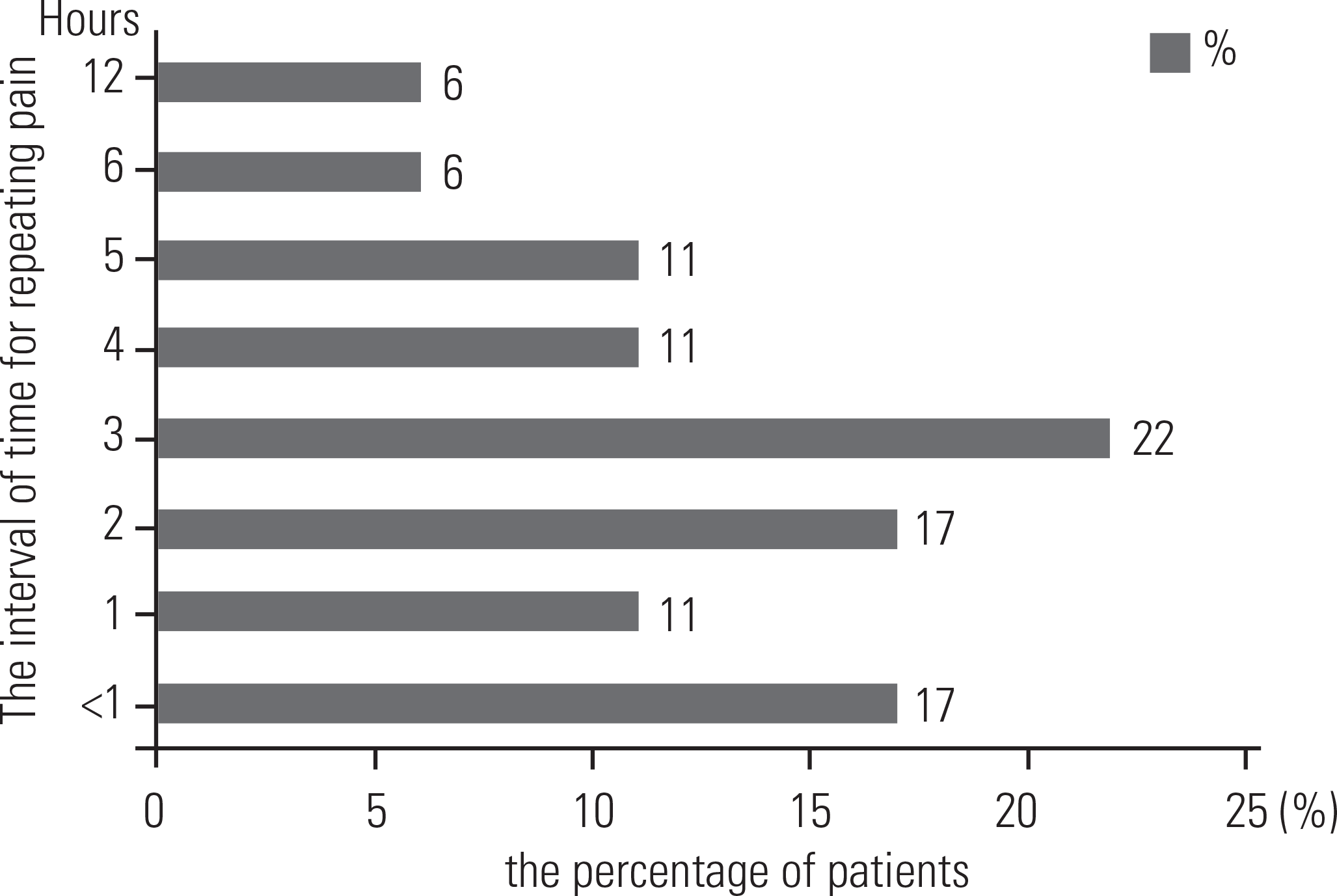Abstract
Objectives
The objective of this study was to investigate the pain status, pain management methods, and pain experience after treatment among patients suffering from chronic non-cancer pain due to spinal disease.
Summary of the Literature Review
No thorough investigation of the current status of chronic non-cancer pain management in patients with spinal disease has recently been reported.
Materials and Methods
We surveyed 330 patients with chronic non-cancer pain who visited spine clinics in Korea.
Results
Prior to treatment, 86.7% of the patients had severe pain and 99.4% of the patients had taken oral analgesics for pain control. After treatment, the percent of patients with severe pain was reduced to 42.1%, and 52.4% of patients responded that they experienced intermittent pain. End of dose failure was experienced by 29.1% of patients, and 41.7% of patients experienced pain again 3–6 hours after taking analgesics. Furthermore, 8.2% of patients experienced breakthrough pain, and 29.1% of patients experienced pain that interfered with sleeping.
Go to : 
REFERENCES
1. Nam EJ. Treatment and approach to patients with chronic pain. Korean J Med. 2007 Aug; 73(2 Suppl):794–805.
2. SNU HQ Center. Principles and methods of chronic pain management. 2015 Jan 21. [updated 2015 Dec 09; cited 2018 Mar 28]. Available from: http://hqcenter.snu.ac.kr/archives/jiphyunjeon/%eb%-a7%8c%ec%84%b1%ed%86%b5%ec%a-6%9d%ea%b4%80%eb%a6%ac%ec%9d%98-%ec%9b%90%ec%b9%99%ea%b3%bc-%eb%b0%a9%eb%b2%95?pnum=0&cat=100.
3. Park JC, Choi YS, Kim JH. Current pharmacological management of chronic pain. J Korean Med Assoc. 2010 Sep; 53(9):815–23. DOI: 10.5124/jkma.2010.53.9.815.

4. Gallagher RM, Welz-Bosna M, Gammaitoni A. Assessment of Dosing Frequency of Sustained-Release Opioid Preparations in Patients with Chronic Nonmalignant Pain. Pain Med. 2007 Jan-Feb; 8(1):71–4. DOI: 10.1111/j.1526-4637.2007.00260.x.

5. Zeppetella G. Impact and management of breakthrough pain in cancer. Curr Opin Support Palliat Care. 2009 Mar; 3(1):1–6. DOI: DOI:10.1097/SPC.0b013e3283260658.

6. Ackerman SJ, Mordin M, Reblando J, et al. Patient-reported utilization patterns of fentanyl transdermal system and oxycodone hydrochloride controlled-release among patients with chronic nonmalignant pain. J Managed Care Pharm. 2003 May-Jun; 9(3):223–31. DOI: 10.18553/jmcp.2003.9.3.223.

7. Seo MS, Shim JY. Breakthrough Cancer Pain. Korean J Hosp Palliat Care. 2015 March; 18(1):1–8. DOI: 10.14475/kjhpc.2015.18.1.1.

8. Kim DY, Song HS, Ahn JS, et al. The dosing frequency of sustained-release opioids and the prevalence of end-of-dose failure in cancer pain control: a Korean multicenter study. Support Care Cancer. 2010 Feb; 19(2):297–301. DOI 10.1007/s00520-010-0825-x.

9. KH Jeong, Choi, JY Park, NS Kim, HY Park. Status of Chronic Pain Prevalence in the Korean Adults. Public Health Weekly Report. 2015; 8(31):728–34.
10. Kim SK, Kim HS, Chung SS. Degrees of Low Back Pain, Knowledge of and Educational Needs for Low Back Pain in Patients with Chronic Low Back Pain. J Muscle Jt Health. 2017 Apr; 24(1):56–65. DOI: 10.5953/JMJH.2017.24.1.56.
11. Chang YJ, Yun YH, Lee IG, et al. Factors of Patient Satisfaction with Pain Management in Cancer Patients. J Korean Acad Fam Med. 2003; 24(9):812–18.
12. Park SY, Park JK, Yang JS, et al. Research on Administration Reality and Satisfaction Level about Taking Narcotic Analgesics. J Kor Soc Health-Syst Pharm. 2008; 25(4):295–303.
13. Kwan TD. Management of acute & chronic pain. Korean J Med. 2011; 81(cho2):96–100.
14. Jeon YH. Recent advances of pain treatment. J Kor Soc Health-Syst Pharm. 2013; 30(5):387–92.
Go to : 
Table 1.
Demographic and disease characteristics
| Characteristic | Number of patients (%) |
|---|---|
| Demographic characteristics | |
| Sex | |
| Male | 133(40.3) |
| Female | 197(59.7) |
| Age (yr) | |
| 20-29 | 8(2.4) |
| 30-39 | 11(3.3) |
| 40-49 | 11(3.3) |
| 50-59 | 42(12.7) |
| 60-69 | 106(32.4) |
| ≥70 | 152(46.1) |
| Disease characteristics | |
| Diagnosis∗ | |
| Headache | 5(1.5) |
| Trigeminal neuralgia | 0(0.0) |
| Facial neuralgia | 0(0.0) |
| Omalgia | 22(6.7) |
| Cervical disc disorder | 21(6.4) |
| Lumbar disc disorder | 219(66.4) |
| Failed back surgery syndrome | 58(17.6) |
| Degenerative knee osteoarthritis | 36(10.9) |
| Rheumatoid arthritis | 17(5.2) |
| Foot and ankle pain | 7(2.1) |
| Diabetic neuralgia | 2(0.6) |
| Others: melosalgia etc. | 27(8.2) |
Table 2.
Pain severity and type at the first visit
Table 3.
Pain management at the first visit
| Number of patients (%) | |
|---|---|
| Pain management | |
| Treatment type∗ | |
| Oral analgesics | 328(99.4) |
| Transdermal analgesic patch | 44(13.3) |
| Analgesic injections | 49(14.8) |
| Antidepressants | 3(0.9) |
| Gastrointestinal agents (pill, gel type et al.) | 103(31.2) |
| Other interventions | 20(6.1) |
| Frequency of oral analgesics† | |
| Once daily | 72(22.0) |
| Twice daily | 183(55.8) |
| Three times daily | 73(22.3) |
| Percentage of pain reduction during the last month | |
| 0% | 1(0.3) |
| 10% | 3(0.9) |
| 20% | 15(4.5) |
| 30% | 28(8.5) |
| 40% | 12(3.6) |
| 50% | 53(16.1) |
| 60% | 32(9.7) |
| 70% | 84(25.5) |
| 80% | 70(21.2) |
| 90% | 26(7.9) |
| 100% | 6(1.8) |
Table 4.
Recent pain severity and type
Table 5.
The incidence of end-of-dose failure, breakthrough pain, an pain in sleep




 PDF
PDF Citation
Citation Print
Print



 XML Download
XML Download